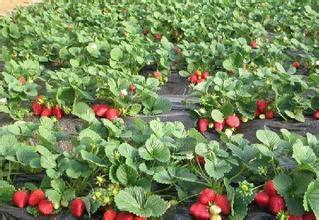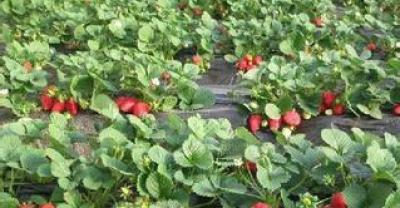Cultivation Techniques of Strawberry Interplanting Tomato in Solar Greenhouse
Luannan County has been growing strawberries for many years, and the "Hongxiang" brand strawberries are exported to Beijing, Tianjin, Qinhuangdao, Tangshan and other large and medium-sized cities. In order to improve the multiple cropping index and get more benefits from the land, Luannan County explored a set of efficient cultivation model of strawberry interplanting tomato in solar greenhouse according to the similar temperature requirements in the growth and development of strawberry and tomato.

1. The theoretical basis of strawberry interplanting tomato.
The temperature requirements of strawberry and tomato in the process of growth and development are similar. The daily temperature from strawberry fruit expansion to ripening period is 1824 ℃, while the suitable growth temperature of tomato is 1425 ℃. This stage is the best period for strawberry interplanting tomato, and the symbiotic period of strawberry and tomato can reach about 4 months. In the early stage of interplanting, tomato is in the seedling stage, which will not affect the growth of strawberry; at the same time, sparse planting of interplanting tomato has little effect on the fruit ripening of strawberry in the later stage. Strawberry has applied a lot of base fertilizer and topdressing during the growth period, and tomato planting can meet its growth needs without further fertilization, which not only reduces the production cost, but also improves the fertilizer use efficiency.
2. Stubble arrangement
Strawberries are generally planted in late August and harvested from mid-January to mid-June the following year. Tomatoes were sown in late November, planted in late February of the following year, and began to appear on the market in early April.
3. Strawberry cultivation techniques.
3.1. Variety selection
According to the needs of production, select varieties with short dormancy period, precocious maturity, disease resistance, cold resistance, appearance and internal quality that meet the market demand, such as all-Star, Tutra, Tong Zi No.1 and so on.
3.2. Raising seedlings
Strawberry seedlings are generally raised from late March to late April, and plots with fertile soil and convenient drainage and irrigation are selected as seedling sites. The mother plant was taken from the mother nursery and planted in the nursery, and the flower buds on the mother plant were removed in time. Generally, the nursery was watered once every 5-7 days, shallow ploughing and no topdressing. In order to promote the mother plant to suck early and draw more stolons, 50 mg/kg of gibberellin 10mg was sprayed on each stolon after removing flower buds, and 2-3 seedlings were left on each stolon.
3.3. Colonization
In every 667m2 fixed planting field, 4 000 kg of rotten organic fertilizer, 750 000 kg of rotten livestock and poultry manure or manure, 10 kg of diammonium phosphate and 10 kg of potassium sulfate were applied and ploughed deeply for 25 cm to form a small high border with a width of 0.8 square meter and a north-south direction. It began to be planted in late August, and strong seedlings with at least 4 leaves without disease and insect pests were selected, and the seedlings must be dug with soil. Two rows were planted in each ridge, the distance between rows was 20~25cm, and the distance between holes was 12: 15 cm. The seedlings were planted in water, and 8 000 seedlings were planted every 667m2. The soil should be kept moist before slow seedling, and small water should be irrigated along the ditch in the slow seedling stage to avoid flood irrigation so as to slow down the seedling root.
3.4. Buckle shed and management
Usually in late October, when the night temperature drops to 8 ℃, buckle the shed. Plastic film was covered 10 to 15 days after the shed was fastened to increase the ground temperature and prevent the growth of weeds. When the seedling grows to the top of the film, cross the membrane in time and lift the seedling to the top of the film. The temperature in the greenhouse was strictly controlled, the daily temperature was 26: 28 ℃ and the night temperature was more than 8 ℃ in the sprouting stage, 20: 25 ℃ and 10: 12 ℃ in the flowering stage, and 18: 25 ℃ and 8 ℃ in the fruit expansion period. When strawberry plants have about 20% budding, 7~10mg/kg gibberellin is sprayed once in the morning on a sunny day to relieve dormancy (do not re-spray). After spraying, the air volume in the greenhouse should be reduced as much as possible and the greenhouse temperature should be kept at about 27 ℃. The amount of irrigation should be controlled during the flowering period, and the soil should be watered in time from fruit setting to fruit ripening to keep the soil dry and wet. Topdressing should follow the principle of "a small amount of fertilizer for many times", topdressing nitrogen fertilizer 5 kg (equivalent to urea 10.9 kg) and potassium fertilizer 4 kg (equivalent to potassium sulfate 8.9kg) every 667m2, according to the seedling condition, spraying appropriate amount of iron fertilizer and 0.3% 0.5% urea and potassium dihydrogen phosphate 2 times 3 times, watering and ploughing in time after fertilization. In the process of strawberry growth, remove old leaves, diseased leaves, stolons and excess lateral buds in time. Before the first flower blooms, leave 7 to 8 florets in each inflorescence and remove the other buds at the front of the inflorescence so that the strawberries bear fruit and the fruit is large and neat. Pollination assisted by bees at flowering stage has the best effect.
3.5. Pest control
The common diseases during strawberry growth are gray mold, bud blight, powdery mildew, virus disease and so on. Dust and smoking should be given priority to reduce the humidity in the greenhouse, and spray control should be carried out in dry and sunny weather. For the prevention and control of Botrytis cinerea, 80g / 100g of 20% Sukeling smoke can be used for prevention and control of Botrytis cinerea every 667m2, or choose 1000 times liquid spray of 50% Sukeling wettable powder or 25% Prohydantoin wettable powder, spray once every 10 days for 2 times. For the prevention and control of bud blight, 5% chlorothalonil dust agent 110-180 g per 667 m2 was ignited in the evening, closed the shed for the night, smoked once every 7 days, and smoked 2 times for 3 times. For the prevention and control of powdery mildew, 50 g of 10% high water dispersible granules can be sprayed after water, or 1 000 times of 20% triadimefon wettable powder can be sprayed every 667 m2. At the initial stage of the onset of virus disease, 20% virus A400 times or 1.5% Zhishiling emulsion 400 times can be sprayed to prevent and control the virus disease.
The pests that often occur during strawberry growth are aphids, whitefly, ground tiger, cabbage armyworm, red spider and so on. Yellow board can be used to trap and kill aphids and whitefly, or silver gray film can be used to avoid aphids; aphids can also be sprayed with 2000 times of aldicarb, or 1 000 times of acetamiprid, or 1500 times of imidacloprid. Ground tiger and cabbage armyworm can be controlled by trapping adults with sugar and vinegar. The method is as follows: wine, water, sugar and vinegar are mixed in a basin according to the ratio of 1 ∶ 2 ∶ 3 ∶ 4, half of the lure is added every 5 days, and all the traps are replaced for 10 days. Red spiders can be sprayed with 1.8% avermectin EC 3000 times or 15% Dipyridene EC 1500 times.
3.6. Harvest
Strawberry fruit ripens about 30 days after flowering and usually begins to be harvested around New Year's Day. If it is used for processing fruit juice or wine, the ripe fruit should be picked; if it is sold nearby, 9% ripe fruit should be picked; if it is shipped to other places for sale or processed into jam, 8 mature fruit should be picked.
4. Tomato cultivation techniques.
4.1. Raising seedlings
Tomato seedlings are usually raised in a greenhouse. The seedling bed is divided into a seed bed and a seedling bed. The seed bed soil is made of 60% pest-free pastoral soil and 40% rotten cow dung, which should be mixed and fine so as to avoid manure burning seedlings; the seed bed soil is made of 50% pastoral soil, 40% rotten organic fertilizer and 10% fine sand. Urea 25g and superphosphate 200g 250g were added to every square meter seedbed (about 10 cm thick bed soil). In addition, each square meter of seeding bed should be sprayed with formalin 30: 50 mL to water for 3 L, then covered with plastic film, sealed for 3 days, and sowed after the smell dissipated. Choose tomato varieties with good taste, medium height, early maturity and disease resistance, such as Dongsheng Warburg, American Pink King, Shanghai 908 and so on. The seed consumption of 667m2 is 35g to 40g, and the seeds are treated before sowing. The sowing began in late November, and the sowing amount was 10: 15g per square meter of seeding bed. When sowing, first pour enough bottom water to the bed soil, after the water seeps, sprinkle a thin layer of nutritious soil on the bed surface (keep the bed flat), then sow, cover the soil 0.8~1.0cm after sowing, and spread it evenly on the bed surface with more than 8 g of carbendazim per square meter of seedling bed, in order to prevent and cure the quenching disease.
4.2. Seedling management
From sowing to seedling stage, the temperature was controlled at 25: 30 ℃ in daytime and 15: 18 ℃ at night. Before the seedling was divided, the temperature was controlled at 20: 25 ℃ in daytime and 10: 15 ℃ at night. From seedling division to slow seedling stage, the temperature was controlled at 25: 30 ℃ in daytime and 15: 20 ℃ at night. From slow seedling to pre-planting, the temperature was controlled at 20: 25 ℃ in daytime and 12: 16 ℃ at night. 5-7 days before planting, the temperature was controlled at 15-20 ℃ in daytime and 8-10 ℃ at night.
When the seedlings have two leaves and one heart, divide the seedlings into the nutrition bowl and put them into the seedling bed, and spray 1000 times of chlorothalonil or mancozeb combined with disease prevention. When the seedling grows 3-4 leaves, the distance between the seedlings is increased, and the gap between the nutrition bowls is filled with fine mud to keep moisture and heat preservation. Seedling stage is mainly to control water and fertilizer, watering enough seedling water, other growth stages according to soil moisture appropriate watering, to avoid too much water, in order to reduce humidity and prevent the occurrence of diseases. The seedling fertilizer can be applied according to the seedling condition when the seedling has 3-4 leaves.
4.3. Colonization and management after colonization
It is usually planted in late February of the following year. Tomato seedlings were planted between two rows of strawberries in the strawberry border. In order to prevent the growth of strawberries from being affected by shading, tomato seedlings should be planted in one row every 667 m ~ 2 with a distance of 2 400 ~ 2 500 plants per 667m ~ 2 25~30cm.
In this period, tomato and strawberry grow together, and the temperature management is the same as strawberry. In order to increase the light intensity and time, a weather-resistant film with good light transmittance should be used to keep the film clean in winter and spring, open the grass in the daytime, and hang a reflective screen at the back of the solar greenhouse. In order to improve the photosynthetic efficiency, carbon dioxide gas fertilizer can be applied in spring, and the suitable concentration is 1000-1500 mg/kg.
Tomato should be watered in time after planting, drip irrigation under plastic film or dark irrigation should be used. The seedlings were watered slowly after planting for 3-5 days, and the seedlings were ploughed in time and watering was controlled. When the first ear of walnut began to be watered, urea 10kg and potassium sulfate 10kg were applied every 667m2, once every 8 to 10 days, and once again according to the above amount of fertilizer when the fruit of the second ear was enlarged. According to the harvest time of tomato, topdressing can be applied for 2 or 4 times, and each topdressing is combined with irrigation.
Tomato must be pruned during the growth period, generally using single-stem pruning, with a thin bamboo pole or nylon rope to hang the vine, leaving 4 ears of fruit in production and then picking the heart. In order to improve the fruit setting rate of tomato, tomato spirit of 25~30mg/kg can be used to protect fruit.
4.4. Pest control
The common diseases in tomato production are early blight, late blight, gray mold, leaf mold, virus disease, spot blight and so on. Early blight can be sprayed with 75% chlorothalonil wettable powder, or 58% metalaxyl ·manganese zinc wettable powder, or 64% alum wettable powder 500x; dust or smoke should be used in cloudy or rainy days, with 5% chlorothalonil dust 1 kg, or 45% chlorothalonil 2005250g, or 10% Prochloraz 200250g per 667m2 each time. Late blight can be sprayed with 72.2% pulic water 800 times or 72% Kelou wettable powder 500 times 600 times, and its smoke and dust control methods are the same as those of early blight. Botrytis cinerea can be used to prevent and control Botrytis cinerea when the first ear is in bloom, 0.1% 50% Sukeling wettable powder or 50% carbendazim wettable powder is added to the prepared dipping solution, and then dipped in the flower or smeared; the second drug for the prevention and control of Botrytis cinerea is carried out one day before pouring the fruit water, and it is sprayed with 800 times of 65% carbendazim wettable powder or 700 times of more than 50% carbendazim wettable powder. At the initial stage of the onset of leaf mildew, each 667m2 can be fumigated with 45% chlorothalonil 250g for one night, or sprayed with 7% chlorothalonil dust in the evening. Virus diseases can be prevented by spraying 1.5% Zhishanling 1000 times or 20% virus A wettable powder. Spot blight can be controlled by spraying 64% alum wettable powder 500 times, or 58% metalaxyl manganese zinc wettable powder 500 times, or 75% chlorothalonil wettable powder 600 times, spraying twice every 10 days or so for 3 times.
Tomato pest control methods refer to strawberries.
4.5. Harvest
Harvest in batches in time to reduce plant burden, ensure fruit quality and promote fruit expansion in the later stage.
- Prev

The vegetables grown in this way can be called truly pollution-free.
Shouguang, the hometown of growing vegetables in Shandong, occasionally had the privilege of going to Shouguang to see with his own eyes the high technology of growing vegetables, which used to be on TV or.
- Next

What matters should be paid attention to in dental implants?
There are a lot of people in life who don't pay attention to some of their eating habits, which can easily affect their teeth, such as not paying attention to some nuts.
Related
- Fuxing push coffee new agricultural production and marketing class: lack of small-scale processing plants
- Jujube rice field leisure farm deep ploughing Yilan for five years to create a space for organic food and play
- Nongyu Farm-A trial of organic papaya for brave women with advanced technology
- Four points for attention in the prevention and control of diseases and insect pests of edible fungi
- How to add nutrient solution to Edible Fungi
- Is there any good way to control edible fungus mites?
- Open Inoculation Technology of Edible Fungi
- Is there any clever way to use fertilizer for edible fungus in winter?
- What agents are used to kill the pathogens of edible fungi in the mushroom shed?
- Rapid drying of Edible Fungi

